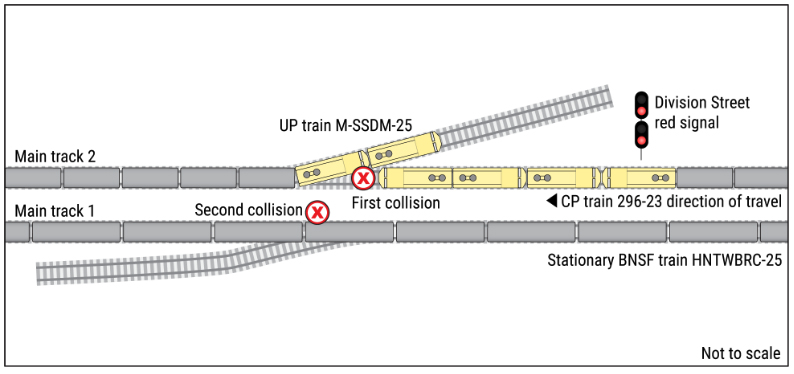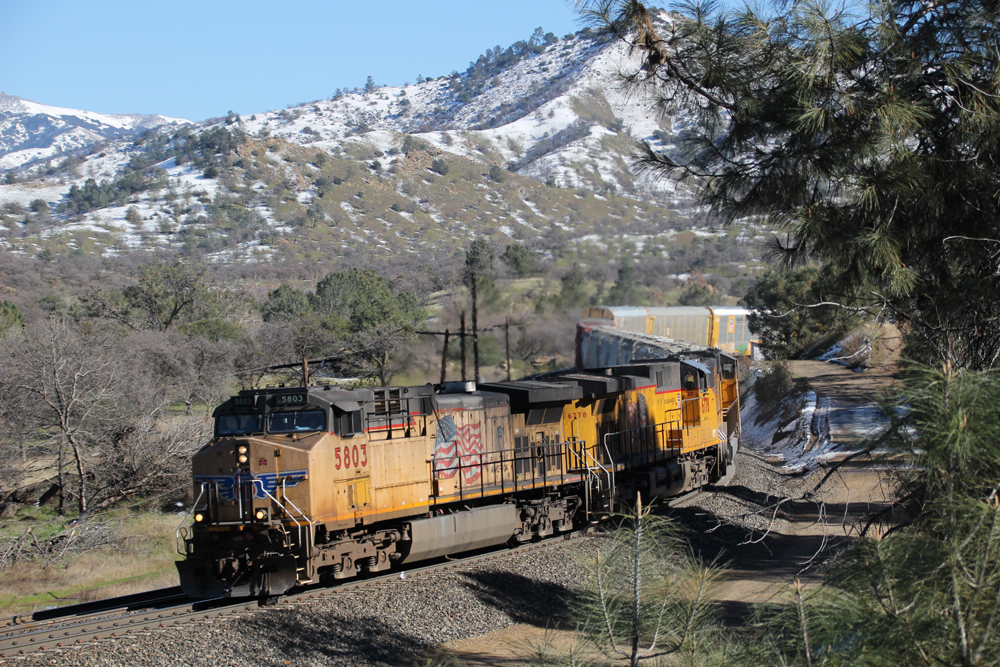
WASHINGTON — Improper handling of train air brakes by the engineer of a Canadian Pacific train was the cause of a three-train accident in St. Paul, Minn., in August 2021, the National Transportation Safety Board has determined.
The accident report, issued Dec. 8, covers an Aug. 25 incident that saw the CP train strike a stopped Union Pacific train, derailing two locomotives on the CP train and one on the UP train. The derailed lead CP locomotive then struck and derailed a car on a BNSF Railway train stopped on an adjacent track [see “NTSB to investigate three-train collision in Minnesota,” Trains News Wire, Aug. 27, 2021]. No injuries were reported. Total damages were estimated at $674,000.
According to the report, CP train 296-23, with four locomotives and 117 caries, was descending a 1.65% grade from a red signal at the Seventh Street control point to a red signal at the Division Street control point, with the engineer using dynamic brakes, which were unsufficient to hold the train. After two air brake applications that proved insufficient to slow the train, the engineer applied emergency braking, but the train passed the red signal at Division street at 19 mph and collided with the other two trains.
The train was not operating under positive train control at the time because of a malfunction aboard the lead locomotive, but was allowed to operate under Federal Railroad Administration rules in effect at the time. Effective Jan. 1, 2023, a train would be prohibited from departing any terminal with a similar malfunction, the report notes.














This article by TRAINS MAG indicates the train had 117 cars and when I clicked thru the included link to the NTSB “Adopted Brief” it states the train had 28 loads and 89 empties. Having personal experience handling trains just exactly like that down the St Paul subdivision (this train came down the adjacent Midway sub), I thought something was screwy after I read the rest of the 10 pages of summary. Ya know what the problem is? The train actually had 89 loads and 28 empties, according to the “MECHANICAL CP TRAIN CONSIST” document included in the docket.
A train with 28 loads and 89 empties is gonna run about 6,600 tons. Dynos might just hold that back if they had 2 units for power (train locomotive consist is listed at 4 but 2 were dead). The ACTUAL car count is 89 loads, 28 empties, totaling 13,265 tons, according to the departure report included in the docket. HUGE difference between 6600 tons and 13,000! Unless my memory is failing me, I’m retired, 2 units did not have enough dynamic breaks to hold 13,000 tons on that grade.
Like to know the tonnage of the train. Possibility the crew was given permission pass the first red OR it was an intermediate signal in which air was used to slow the train down and the air did not recover enough to allow for proper braking at the stop signal.
In my own experience I use the air in combo with dynamic to bring the train down to a speed in which it will allow enough time for a proper recovery of the air. After one application and nothing happening it should have been dumped. Forget the second app.
The accident report leaves out a lot of information. The train had four locomotives, but were they all online? What was the tons/DBA? How much dynamic brakes did the engineer use to control the train? Why were the dynamic brakes insufficient to control the train while the brakes were recovering?